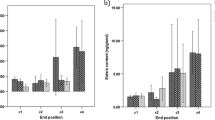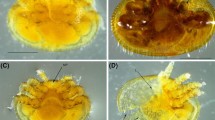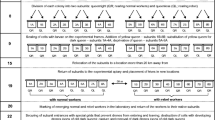Summary
The timing of queen rearing and swarming are described after queens were removed from colonies of Africanized bees. New queens were reared from newly hatched to three day old worker larvae, many of which were moved in the egg or newly eclosed larval stages by workers into newly constructed queen cells. Mortality of worker eggs and larvae following dequeening was high, averaging 50%. When new queens emerged, swarms issued from two-thirds of the colonies. This process of queen replacement and queen-loss swarming differs from that of reproductive swarming in the lack of preparation before queen loss, longer queenless interval, lack of correlation between number of swarms and sealed brood area or number of queen cells, and lack of Congestion in colonies when swarms issued.
Resume
Nous décrivons le «timing» de l'élevage des reines et de l'essaimage après avoir enlevé la reine dans des colonies d'abeilles «africanisées». De nouvelles reines ont été élevées à partir de larves de moins de 3 jours; beaucoup de celles-ci et beucoup d'œufs ont été déplacés par les ouvrières dans des cellules de reines nouvellement construites. Le taux de mortalité les ouvrières dans des cellules de reines nouvellement ouvrières a été élevé, en moyenne de 50%, après l'orphelinage expérimental. A l'éclosion des nouvelles reines, 2/3 des colonies ont essaimé. Ces processus de remplacement de la reine et d'essaimage après la perte de celle-ci diffèrent de ceux des essaimages de reproduction par le manque de préparation avant la perte de la reine, un intervalle de temps sans rene plus long, et une absence de l'essaimage. Par ailleurs il n'y a pas de corrélation entre le nombre d'essaims et la surface occupée par le couvain operculé ou le nombre de cellules royales.
Similar content being viewed by others
References
Anonymous, 1972. — Final report, Committee on the African Bee.Natl. Acad. Sci. (Wash.).
Chauvin R., 1968. — Elevage et biologie de la reine,in Traité de biologie de l'abeille, Ed. R. Chauvin, vol. 2: Système nerveux, comportement et régulations sociales.Masson, édit., Paris.
Fletcher D.J.C., 1975. — Significance of dorsoventral abdominal vibration among honey bees (Apis mellifera L.).Nature, 256, 721–723.
Fletcher D.J.C., 1978 a. — Vibration of queen cells by worker honey bees and its relation to the issue of swarms with virgin queens.J. Apic. Res., 17, 14–26.
Fletcher D.J.C., 1978 b. — The African bee,Apis mellifera adansonii, in Africa.Ann. Rev. Entomol., 23, 151–171.
Fletcher D.J.C., Tribe G.D., 1977 a. — Natural energency queen rearing by the African beeApis mellifera adansonii and its relevance for successful queen production by beekeepers, I. in African bees: Taxonomy, Biology, and Economic Use.Proc. Apimondia Inter. Symp., Pretoria, South Africa, Ed. D.J.C. Fletcher, pp. 132–140.
Fletcher D.J.C., Tribe G.D., 1977 b. — Natural emergency queen rearing by the African beeApis mellifera adansonii and its relevance for successful queen production by beekeepers, II. in African bees: Taxonomy, Biology, and Economic UseProc. Apimondia Inter. Symp., Pretoria, South Africa, Ed. D.J.C. Fletcher, pp. 161–168.
Fletcher D.J.C., Tribe G.D., 1977 c. — Swarming potential of the African bee,apis mellifera adansonii L.,in African bees: Taxonomy, Biology, and Economic Use.Proc. Apimondia Inter. Symp., Pretoria, South Africa, Ed. D.J.C. Fletcher, pp. 25–34.
Taylor O.R., 1977. — The past and possible future spread of Africanized honeybees in the Americas.Bee World, 58, 19–30.
Winston, M.L., 1978. — Intra-colony demography of the Africanized honeybee in South America. Ph.D. Dissertation,University of Kansas, Lawrence, Kansas, U.S.A.
Winston, M.L., 1979. — Intra-colony demography and reproductive rate of the Africa nized honeybee in South America.Behav. Ecol. Sociobiol., 4, 279–292.
Winston, M.L., Otis G.W., 1978. — Ages of bees in swarms and afterswarms of the Africanized honeybee in South America.J. Apic Res. 17, 123–129.
Winston M.L., Taylor O.R., 1979. — Factors preceding queen rearing in the Africanized honeybee (Apic. mellifera) in South America.Insi. Soc. (in press).
Woyke J., 1971. — Correlations between the age at which honeybee brood was grafted, characteristics of the resultant queens, and results of insemination.J. Apic. Res.,10, 45–55.
Author information
Authors and Affiliations
Additional information
Contribution: 1695 from the Department of Entomology, University of Kansas, Lawrence, Kansas 66045, U.S.A.
Rights and permissions
About this article
Cite this article
Winston, M.L. Events following queen removal in colonies of Africanized honeybees in South America. Ins. Soc 26, 373–381 (1979). https://doi.org/10.1007/BF02223556
Received:
Accepted:
Published:
Issue Date:
DOI: https://doi.org/10.1007/BF02223556




